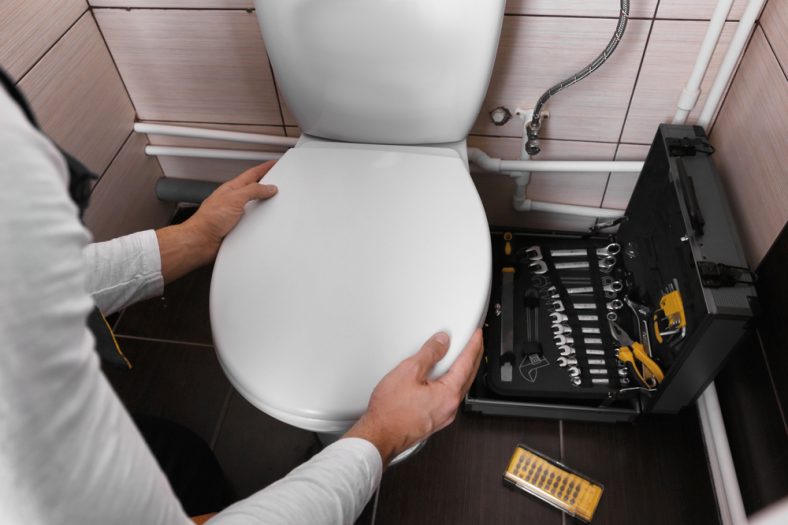Modern Toilet seats do not contain any physically appeared nuts and bolts. Thus, you are looking at how to tighten the toilet seats with no access underside. Therefore, we are providing you an informational guide regarding your concern.
Plus, simple steps are mentioned below that will guide you in tightening the toilet seat without having access to screws or nuts.
Moreover, instead of inviting others, you can now fix or change the toilet seat as your own. You did not have to spend money on a plumber to fix the toilet seat; follow the information provided here to tighten your Toilet seat.
Contents
How to Tighten Toilet Seat with No Access Underside?
What are the tools needed to tighten the Toilet seats?
- Safety gloves
- Safety glasses
- Masks for face protection
- Slotted and Phillips screwdriver
- Rust removal oil
Above mentioned tools are enough for the successful tightening of a toilet seat.
Findings of Hidden Screws
Hidden nuts and bolts finding inside your toilet seats do not depend upon the seat type. Approximately all modern toilet seats contain similar places where nuts and bolts are hidden. To find out the nuts in the toilet seat, lift your toilet seat.
After lifting the toilet seat, you will find a single button or double button beneath the toilet seat. Just press the controls, and the center will be detached from the whole toilet pot. Now, you will see some caps after lifting the toilet seat. Pull the hats up, and then you will see the hidden screws and bolts under the lids.
To untie or tighten the screws, different types of tools are required.
Procedures to Tighten Toilet Seat
Waiting for a plumber and paying them for work is very difficult, but fixing the toilet seat without help is significantly more comfortable. So, we are providing a stepwise guide to you for toilet seat tightening. Below mentioned steps are enough for the successful tightening of the toilet seat.
Step 1:
In the very first step, you have to take precautionary measures for your safety. To ensure safety, put on safety glasses for eye protection and safety gloves to protect hands. The stern face mask will protect your nose and teeth from damage in case you slipped out.
Make sure that you should use transparent eyeglasses; dark eyeglasses will not comfort your work. Gloves should not be too hard or too soft; ideal gloves provide effectiveness in fixing a toilet seat.
Step 2:
After safety precautions, lift the toilet seat and press the buttons below the toilet seat, which you will find near the toilet seat’s hinge. After pressing the controls, the toilet seats will be detached. Now, place the toilet seat beside and focus on the hinges which are left behind.
Step 3:
Hinges will hook like a single round-headed spike. On the lower side of the hinge, you will find out a cap. These caps are attached to the hinges with the help of magnets.
Grab the lid and lift it. This requires little effort, but caps of hinges can be removed easily. After removing the cap, you will see a screw which is needed to be tightened.
Step 4:
Tightening of the screw will cause the tightening of seats. Once you pull the screw, you will found your heart fully fixed. Before tightening, make sure which screwdriver will help you fixing the Toilet seat.
Phillip screws need a Phillips screwdriver, and slotted screws need a slotted or flat-faced screwdriver. Usually, screws of toilet seats are tightened with the help of a Phillips screwdriver.
Step 5:
After finding the type of screwdriver need, grab the screwdriver and tighten the screw. While tightening the screw, pull up the hinge a little bit for perfect tightening.
As there is a spring beneath the hinge so you will find little tension on pulling the hinge. Please do not pull the hinge so much because it may damage the hinge. Only remove the hinge by hand because this provides enough compression on the spring of the hinge.
Step 6:
After tightening the screw, make sure that the hinge is fully tightened or not. Finding any looseness in the hinge will not tighten the toilet seat. Tight the screw if you found any looseness in the hinge. The primary purpose of the spring beneath the hinge is to provide enough tension, which increases the hinge’s tightness.
Step 7:
After confirmation of the perfect tightening of the hinge, place the cap on the screws. Usually, the seat cap protects the screws from rusting. If you found any rusting on the screws, apply a little rust removal oil on screws.
Now place the seat cover again on the hinge spikes. Make sure that hinges and buttons are correctly aligned. Press the Toilet seat downwards and make sure that the buttons perfectly hold the hinges or not.
In the case of non-alignment of hinges, twist the cap and adjust the hinges’ position accordingly. When you found a perfect alignment of hinges and buttons, press the toilet seat downward, and regulators will hold the hinges correctly.
Step 8:
The final step of tightening of toilet seat includes checking the toilet seat tightness. To find out the toilet seat’s perfect tightness just provide upward and downward movement to the seat. The probability of your seat tightness is 100% when you check the tightness of the toilet seat.
Conclusion:
Fixing Toilet seat tightness is not a very difficult task. People can quickly fix their toilet seats with the help of the steps provided here. There is no need to call for a plumber or anyone else to fix the toilet seat. A simple mechanism is provided in the toilet seats, which will hide the screws of the toilet seat. With the steps mentioned above, you can find out hidden screws by pressing a single button.

